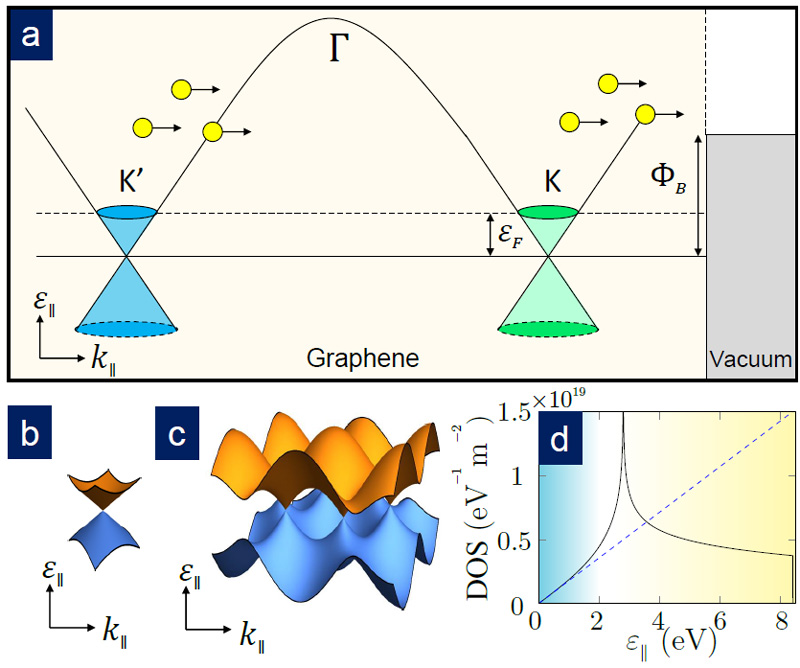SUTD Physicists Unlock the Mystery of Thermionic Emission in Graphene
SUTD researchers discover a new theory that paves the way for the design of better graphene electronics and energy converters.
When a metal is heated to a sufficiently high temperature, electrons can be ejected out from the surface in a process known as the thermionic emission, a process that is similar to the evaporation of water molecules from the surface of boiling water.
The thermionic emission of electron plays an important role in both fundamental physics and digital electronic technology. Historically, the discovery of thermionic emission enables physicists to produce beams of free-flowing electrons in a vacuum. Such electron beams had been used in the hallmark experiment performed by Clinton Davisson and Lester Germer in the 1920s’ to illustrate the wave-particle duality of electrons – a bizarre consequence of quantum physics, which marked the dawn of the modern quantum era. Technologically, thermionic emission forms the core of the vacuum tube technology – the precursor of modern-day transistor technology – that enabled the development of the first-generation digital computer. Today, thermionic emission remains one of the most important electricity conduction mechanisms that governs the operation of billions of transistors embedded in our modern-day computers and smartphones.
Although the thermionic emission in traditional materials, such as copper and silicon, has been well-explained by a theoretical model put forward by British physicist O. W. Richardson in 1901, exactly how thermionic emission takes place in graphene, a one-atom thin nanomaterials with highly unusual physical properties, remains a poorly understood problem.
Understanding the thermionic emission from graphene is particularly important as graphene may hold the key to revolutionizing a vast array of technologies, including computing electronics, biological sensor, quantum computer, energy harvester, and even mosquito repellent. Graphene and its broader family of atomically-thin nanomaterials – also known as ‘2D materials’ – have been highlighted as the top 10 emerging technologies by the World Economic Forum in 2016.
Reporting in Physical Review Applied, researchers from the Singapore University of Technology and Design (SUTD) have discovered a general theory that describes the thermionic emission from graphene. By carefully studying the electronic properties of graphene, they have constructed a generalized theoretical framework that can be used to accurately capture the thermionic emission physics in graphene and is suitable for the modeling of a wide range of graphene-based devices.
“We found that the conduction of electricity and heat energy arising from thermionic emission can deviate by more than 50% when erroneously calculated using the standard Dirac cone approximation,” said Yueyi Chen, an SUTD undergraduate student who participated in this research.
The electronic property of graphene is often described by the ‘Dirac cone approximation’, a simple theoretical framework based on the unusual behavior of electrons in graphene that mimics fast-moving particles living in the ultrarelativistic regime. This Dirac cone approximation has formed the standard paradigm for the understanding of graphene physical properties and is a cornerstone model for the design of many graphene-based electronic, optoelectronic and photonic devices.
However, when electrons in graphene are thermally or optically excited into higher energy states, they stop obeying the Dirac cone approximation. The SUTD researchers realized that using the Dirac cone approximation to model the thermionic emission of highly-excited electrons from graphene can lead to spurious results, producing highly unreliable prediction that deviates significantly from the actual performance of the graphene electronic and energy devices.
The new approach developed by SUTD researchers significantly improves the reliability of their model by using a more sophisticated theory that fully captures the electronic properties of graphene in the high-energy regime, thus circumventing the low-energy limitation as required by the Dirac cone approximation. Without relying on the Dirac cone approximation, this new thermionic emission model now allows a wide array of graphene-based devices operating at different temperatures and energy regimes to be universally described under a single framework (refer to image).
“The generalized model developed in this work will be particularly valuable for the design of cutting-edge waste-heat-to-electricity converters and low-energy electronics using graphene, which may offer new hopes in reducing the energy footprint of the next-generation computing and communication devices,” said Professor Ricky L. K. Ang, Head of Science and Math Cluster at SUTD.
 (a) The energy band structure illustrating the thermionic emission process of electrons in graphene at different energy states; (b) Low-energy band structure of graphene under the Dirac cone approximation; (c) More general energy band structure of graphene covering both low and high energy regime; (d) Large discrepancy between the electronic density of states predicted by the band structure theory in (b) and in (c).
(a) The energy band structure illustrating the thermionic emission process of electrons in graphene at different energy states; (b) Low-energy band structure of graphene under the Dirac cone approximation; (c) More general energy band structure of graphene covering both low and high energy regime; (d) Large discrepancy between the electronic density of states predicted by the band structure theory in (b) and in (c).
The paper 'Generalized High-Energy Thermionic Electron Injection at Graphene Interface' is published in Physical Review Applied.